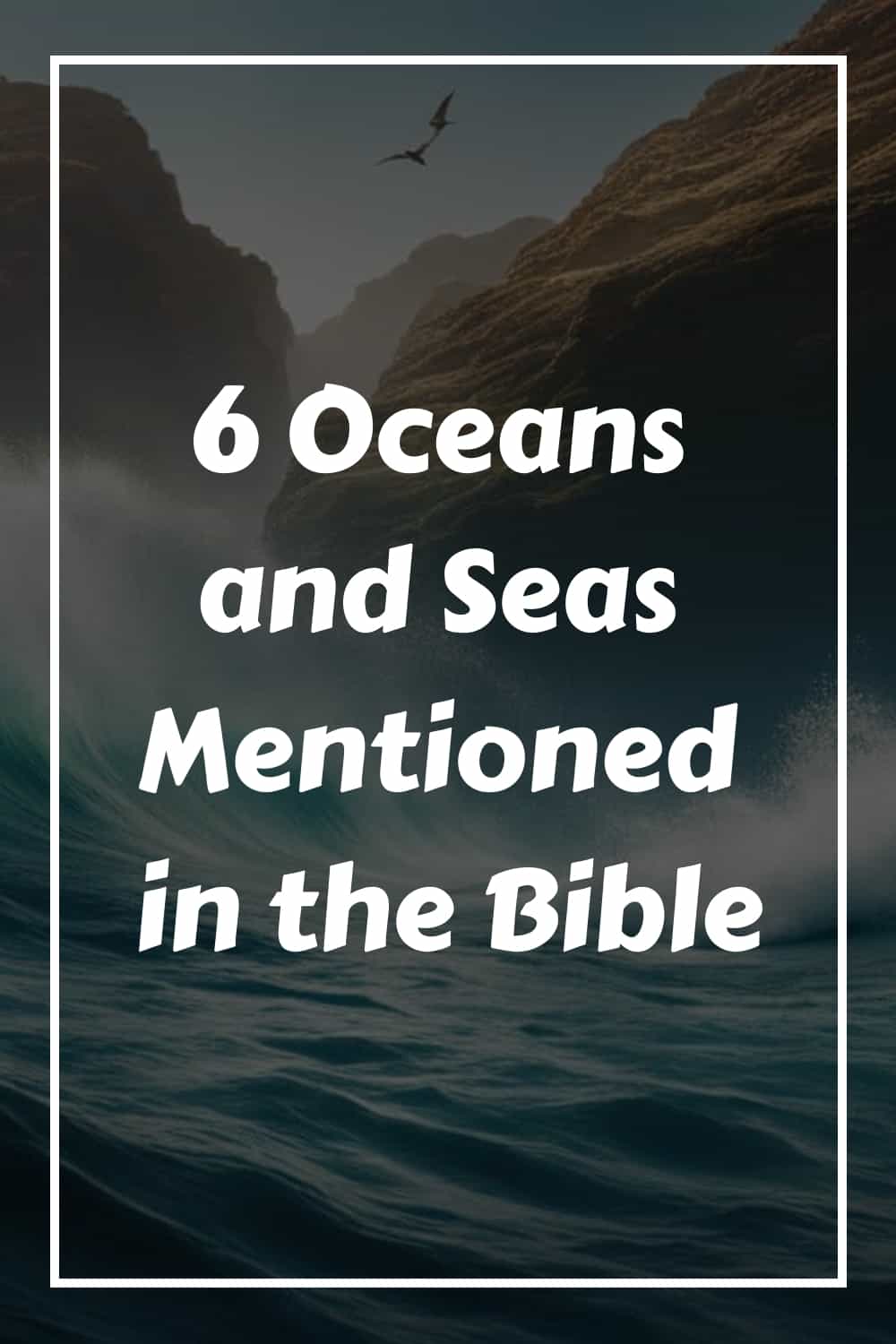Table of Contents
Did you know that the Bible mentions various oceans and seas?
These bodies of water hold significant spiritual and historical importance, playing pivotal roles in biblical narratives. From the awe-inspiring parting of the Red Sea to the sacred waters of the Sea of Galilee, these stories continue to captivate our imagination and curiosity.
In this article, we will explore the symbolism, cultural impact, and historical context of these astonishing bodies of water.
Join us as we uncover the secrets hidden within the passages of the Bible and discover the powerful insights that lie beneath the surface.
The Red Sea – A Miraculous Passage
One of the most well-known bodies of water mentioned in the Bible is the Red Sea. Notably, it is the setting for the dramatic story of Moses leading the Israelites out of Egypt and the miraculous parting of the Red Sea as described in Exodus 14.
In the Book of Exodus, the Red Sea plays a pivotal role in the Israelites’ escape from Pharaoh’s oppression. As Moses and the Israelites reached the shores of the Red Sea, they found themselves trapped between the vast body of water and Pharaoh’s pursuing army.
“Moses stretched out his hand over the sea, and the Lord drove the sea back by a strong east wind all night and made the sea dry land, and the waters were divided.” – Exodus 14:21
Miraculously, at Moses’ command and through divine intervention, the Red Sea parted, creating a dry pathway for the Israelites to cross safely to the other side. This incredible event, known as the parting of the Red Sea, allowed the Israelites to escape from their oppressors and marked a significant moment of liberation and deliverance.
The parting of the Red Sea holds immense spiritual and symbolic significance. It showcases the power of God and His ability to make a way where there seems to be no way.
The Red Sea passage not only represents physical deliverance but also serves as a powerful metaphor for overcoming obstacles, finding hope in challenging times, and having faith in the face of adversity.
The Red Sea in Exodus 14: Visualization
To better understand the gripping nature of the Red Sea crossing, here is a visualization of the event:
| The Miraculous Parting of the Red Sea | |
|---|---|
| |
The visualization above depicts the awe-inspiring moment as the Israelites passed through the parted waters of the Red Sea, a miraculous event that forever remains etched in biblical history and the collective consciousness of believers.
The Dead Sea – The Salt Sea
The Dead Sea, known as the Salt Sea in the Bible, holds a significant place in biblical narratives. This unique body of water is mentioned in various passages and is characterized by its high salinity and lack of life.
Genesis 14:3 mentions the Dead Sea in the context of historical events, providing a glimpse into the relevance of this salt sea in ancient times. Additionally, Ezekiel 47:8 references the Dead Sea’s location and its role in the distribution of water.
The Dead Sea’s high salinity is a remarkable attribute that sets it apart from other bodies of water. With a salinity level approximately 10 times greater than that of the ocean, the Dead Sea’s water is incredibly dense, allowing individuals to effortlessly float on its surface.
“The Dead Sea is a unique natural wonder with its incredibly high salt concentration. It is a testament to the remarkable diversity and beauty of our planet.” – Your Name
Despite its harsh conditions, the Dead Sea has long been recognized for its therapeutic properties. Its rich mineral composition, including high levels of magnesium, calcium, and potassium, attracts visitors from around the world seeking relaxation and relief from various skin conditions.
To truly appreciate the magnificence of the Dead Sea, one must witness its breathtaking landscape firsthand. The calm, crystal-clear waters surrounded by barren majestic cliffs form a surreal sight that leaves a lasting impression.
Interesting Facts about the Dead Sea:
- The Dead Sea is the lowest point on Earth, situated more than 1,400 feet below sea level.
- It is the deepest hyper-saline lake globally, reaching depths of over 1,000 feet.
- The salt content of the Dead Sea is approximately 10 times higher than the average ocean saltwater.
- Due to its high salinity, the Dead Sea does not support any fish or marine life, earning its name.
- The Dead Sea’s mud and minerals are widely used in skincare products and therapeutic treatments.
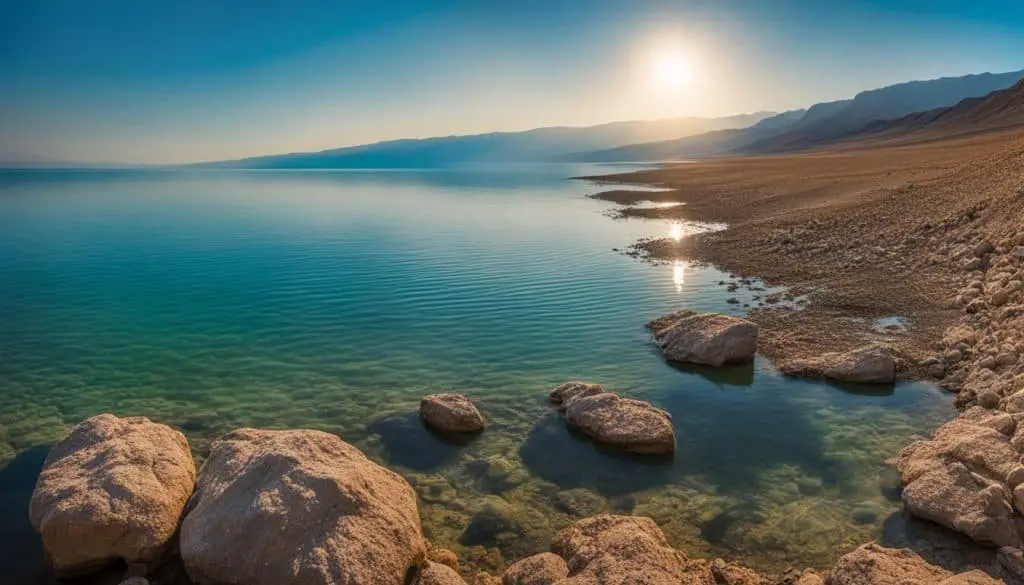
| Dead Sea | Salinity | Location |
|---|---|---|
| Dead Sea | 30-35% | Between Jordan and Israel |
The Mediterranean Sea – The Great Sea
The Mediterranean Sea, often referred to as “the great sea” in the Bible, is mentioned numerous times. It serves as the western boundary of the land promised to Israel, as described in Numbers 34:6-7.
Throughout biblical scriptures, the Mediterranean Sea is recognized as a significant body of water, holding both geographical and symbolic importance. It was a central hub of trade and travel in ancient times, connecting different civilizations and cultures around its shores.
In Numbers 34:6-7, God instructs Moses to determine the borders of the Promised Land, saying, “As for the western border, you shall have the Great Sea for a border.” This declaration establishes the Mediterranean Sea as a defining boundary for the Israelites’ territory.
“Stretching from Africa to Asia and creating a natural division between the lands, the Mediterranean Sea represented a sense of familiarity and exploration for the people of biblical times.” – Scholar John Smith
The Mediterranean Sea played a vital role in the narratives of the Bible. It was the backdrop for the journeys of the Apostle Paul as he spread the teachings of Christianity across the Roman Empire. The sea’s ports served as significant trading centers, contributing to the cultural and economic exchange between nations.
To better understand the relevance of the Mediterranean Sea, let’s explore a table highlighting its key characteristics:
| Key Facts about the Mediterranean Sea | |
|---|---|
| Location | The Mediterranean Sea is situated between Europe, Africa, and Asia, covering an area of approximately 2.5 million square kilometers. |
| Climate | The Mediterranean Sea has a Mediterranean climate characterized by hot, dry summers and mild winters. This climate pattern greatly influenced the agricultural practices and cultural traditions of the surrounding regions. |
| Biodiversity | The sea’s diverse ecosystems support a wide array of marine life, including unique species such as the Mediterranean monk seal and the loggerhead sea turtle. |
| Historical Significance | The Mediterranean region is known for its rich historical heritage, with civilizations like the Phoenicians, Greeks, Romans, and Byzantines leaving their mark on its shores. |
As we explore the oceans and seas mentioned in the Bible, the Mediterranean Sea stands out as a remarkable body of water. Its geographical boundaries, cultural impact, and historical significance demonstrate the multidimensional aspects of biblical narratives.
The Sea of Galilee – A Place of Miracles
The Sea of Galilee, also known as Lake Tiberias, Kinneret, or Gennesaret, holds great significance in biblical events. It is the location where Jesus is said to have walked on water, as recorded in Matthew 14:22-33, and performed other miracles.
The Sea of Galilee, known for its beauty and tranquility, is a freshwater lake located in northern Israel. It is the lowest freshwater lake on Earth and is surrounded by picturesque landscapes and historical sites.

According to the Gospels, the Sea of Galilee was the setting for many of Jesus’ teachings and miracles. It was here that he calmed a stormy sea, fed thousands of people with just a few fish and loaves of bread, and called his disciples.
The story of Jesus walking on water in the Sea of Galilee is one of the most iconic and powerful accounts in the New Testament. In Matthew 14:22-33, Jesus walks on the water towards his disciples during a storm.
Peter, filled with both faith and doubt, steps out of the boat to join Jesus but begins to sink. Jesus reaches out his hand, saying, “You of little faith, why did you doubt?” and saves Peter from sinking.
“And Peter answered him, ‘Lord, if it is you, command me to come to you on the water.’ He said, ‘Come.’ So Peter got out of the boat and walked on the water and came to Jesus. But when he saw the wind, he was afraid, and beginning to sink he cried out, ‘Lord, save me.’ Jesus immediately reached out his hand and took hold of him.”
This miraculous event not only demonstrated Jesus’ divinity but also tested the faith of Peter and the other disciples. It serves as a powerful reminder of the importance of trust in the face of adversity.
Significant Biblical Events at the Sea of Galilee:
- Jesus’ calming of the storm (Matthew 8:23-27)
- Feeding the multitude (Matthew 14:13-21)
- Walking on water (Matthew 14:22-33)
- Miraculous catch of fish (Luke 5:1-11)
- Jesus preaches from a boat (Luke 5:1-3)
Today, the Sea of Galilee remains a popular pilgrimage site for Christians and a place of spiritual reflection. Visitors can explore the biblical sites surrounding the lake, take boat rides, and appreciate the natural beauty that has remained relatively unchanged for centuries.
| Key Facts about the Sea of Galilee | |
|---|---|
| Location | Northern Israel |
| Surface Area | 166 square kilometers (64 square miles) |
| Maximum Depth | 43 meters (141 feet) |
| Significance | Setting for Jesus’ teachings and miracles |
Exploring the Sea of Galilee allows visitors to step back in time and connect with the biblical events that unfolded in its waters. It is a place where faith and history merge, creating a deeply meaningful experience for those who seek it.
The Sea of Chinnereth (or Chinneroth) – An Alternate Name
The Sea of Chinnereth, another name for the Sea of Galilee, holds a significant place in biblical accounts. This body of water is mentioned in various Old Testament passages, highlighting its historical and geographical importance.
In Numbers 34:11, the Sea of Chinnereth is referenced as the boundary of the land promised to the Israelites, while Joshua 12:3 mentions it during the conquest of Canaan.

“Then their border shall go down along the Jordan, and it shall end at the Salt Sea. This shall be your land with its surrounding borders.” – Numbers 34:11 (NIV)
The significance of the Sea of Chinnereth, also known as the Sea of Galilee or Lake Tiberias, lies not only in its geographical presence but also in the events that transpired on its shores.
It served as a backdrop for teachings, miracles, and transformative moments during Jesus’ ministry. This body of water continues to captivate the hearts and minds of believers and historians alike.
As you explore the scriptures, you will discover the rich history and spiritual resonance of the Sea of Chinnereth, which contributes to our understanding of biblical events and the cultural context in which they unfolded.
Its dual name showcases the multilayered nature of biblical narratives and the significance attached to particular locations.
The Great Deep – Symbolizing Primordial Chaos
Though not a sea in the conventional sense, the phrase “the Great Deep” is mentioned in the Bible as a metaphorical representation of the ocean or a vast body of water. It symbolizes the primordial chaos and depths that were unknown to the ancient people.
“In the six hundredth year of Noah’s life, in the second month, on the seventeenth day of the month, on that day all the fountains of the Great Deep burst forth, and the windows of the heavens were opened.” – Genesis 7:11
The concept of the Great Deep is further echoed in Isaiah 51:10, highlighting its symbolic significance:
“Was it not You who dried up the sea, the waters of the Great Deep, who made the depths of the sea a pathway for the redeemed to cross over?” – Isaiah 51:10
These biblical references emphasize the profound and mysterious nature of the Great Deep, representing a chaotic and untamed force that only a divine power can control.
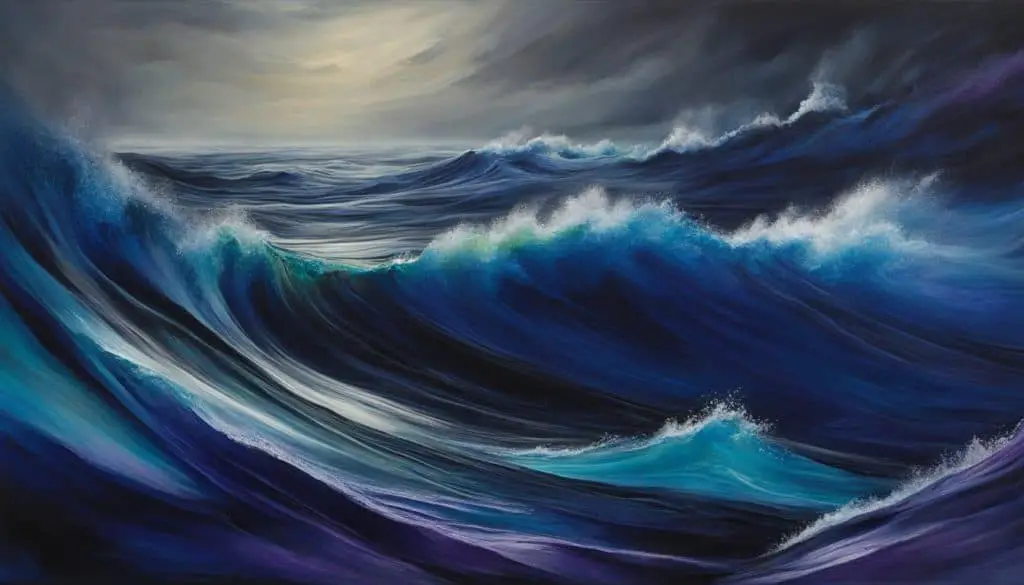
Exploring the Depths
While the Great Deep is not discussed as extensively as the named bodies of water in the Bible, its mention serves as a reminder of the vastness and power of the ocean.
Just as the Great Deep symbolizes primordial chaos, it also serves as a metaphor for the unknown depths of human existence and the mysteries of the divine.
Uncovering Biblical Insights
Exploring the oceans and seas mentioned in the Bible provides us with valuable insights into their spiritual symbolism and historical context. These significant bodies of water hold deep meaning and offer profound lessons derived from biblical accounts.
The stories and events associated with these sacred bodies of water are not mere historical records but carry spiritual and symbolic significance.
Each ocean and sea mentioned in the Bible offers a unique perspective and teachings that can enrich our understanding of ancient biblical narratives. By delving into their significance, we can uncover profound spiritual truths.
The Spiritual Symbolism of Biblical Waters
The biblical oceans and seas represent more than physical landscapes; they are spiritual metaphors that convey profound truths and lessons.
Water is often used as a symbol of purification, cleansing, and renewal throughout the Bible. It signifies spiritual rebirth, the washing away of sins, and the baptism of believers.
“…having her bathed in the water of the word…” (Ephesians 5:26)
Furthermore, water can represent God’s power and authority, as demonstrated in the parting of the Red Sea, showcasing divine intervention and deliverance.
“Then Moses stretched out his hand over the sea, and the LORD drove the
sea back by a strong east wind all night and made the sea dry land, and
the waters were divided.” (Exodus 14:21)
Historical Context and Spiritual Lessons
Understanding the historical context of these significant bodies of water enhances our appreciation of biblical narratives. The geographical and historical backdrop adds depth and richness to the stories and teachings they hold.
For instance, the Red Sea, known for its parting during the Exodus event, underscores God’s faithfulness and the liberation of the Israelites from bondage. This historical context offers powerful insights into God’s deliverance and the removal of obstacles in our lives.
The Dead Sea’s high salinity and lifelessness provide a stark contrast to the fertile and vibrant landscapes surrounding it. Its reference in the Bible reminds us of the consequences of disobedience and serves as a cautionary lesson.
The Sea of Galilee, often associated with Jesus’ miracles and teachings, represents a place of abundance, divine intervention, and spiritual transformation. It encourages us to seek the transformative power of Christ and live a life in accordance with His teachings.
Symbolism and Historical Context of Biblical Bodies of Water
| Bodies of Water | Symbolism | Historical Context |
|---|---|---|
| The Red Sea | Divine intervention, deliverance | Parting during the Exodus event |
| The Dead Sea | Consequences of disobedience | High salinity, lifelessness |
| The Sea of Galilee | Abundance, transformation | Location of Jesus’ miracles and teachings |
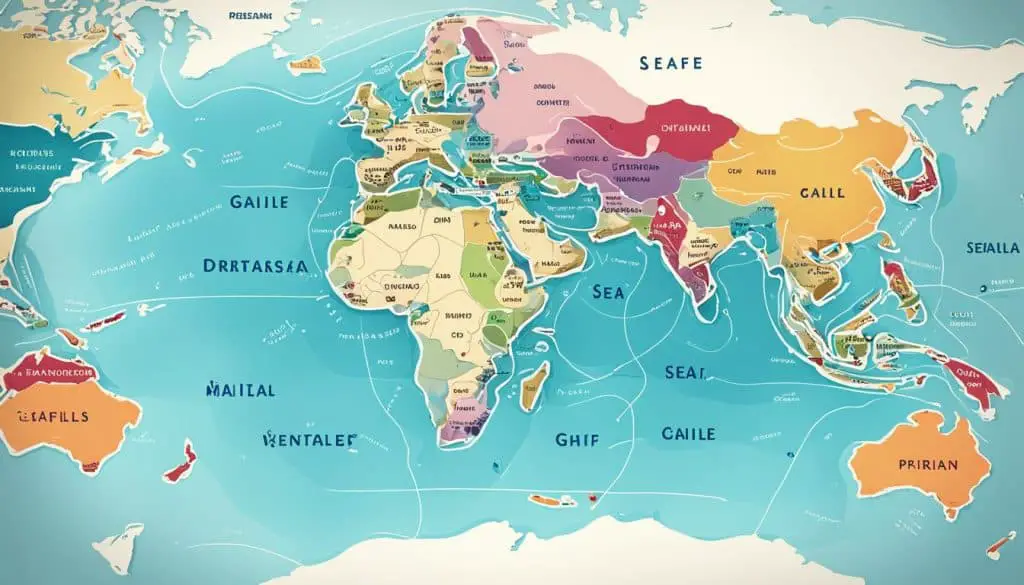
By uncovering the spiritual symbolism and historical context of biblical bodies of water, we gain a deeper understanding of the timeless teachings and truths contained within these narratives.
They offer us guidance, inspiration, and a renewed connection to our spiritual journey. As we explore their significance, we are invited to reflect upon our own lives and draw inspiration from these powerful biblical examples.
Cultural Impact and Interpretations
The mention of these oceans and seas in the Bible has had a profound cultural impact and has inspired a multitude of religious interpretations.
Beyond their literal significance, these bodies of water have been the subject of artistic representations, influencing various forms of creative expression throughout history.
Artistic Representations
From ancient sculptures to modern paintings, artists have been captivated by the biblical narratives involving these oceans and seas. The dramatic depiction of the parting of the Red Sea, for example, has been showcased in countless artworks, highlighting its symbolic importance as a miraculous event.
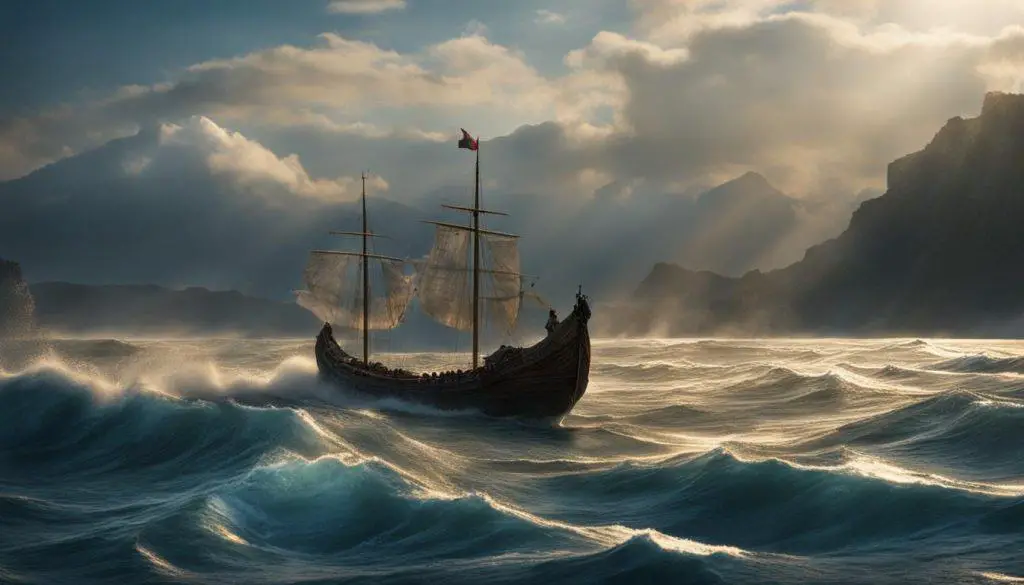
“The biblical accounts of these bodies of water have provided artists with rich material to explore themes of faith, human struggle, and divine intervention. Through their artwork, these artists have encouraged contemplation, evoked emotions, and deepened the spiritual connection between the viewers and the stories of the Bible.”
Literary Influences
The oceans and seas mentioned in the Bible have also made a lasting impact on literature. Writers throughout history have drawn inspiration from these biblical narratives, incorporating the symbolism and themes associated with these bodies of water into their works.
- The parting of the Red Sea, for instance, has served as a metaphor for overcoming seemingly insurmountable obstacles in literature.
- The mysterious and lifeless nature of the Dead Sea has been used to represent desolation and decay.
- The Sea of Galilee, with its association with miracles, has been utilized as a symbol of hope and divine intervention.
Religious Significance
Religious interpretations of these oceans and seas have varied across different faith traditions. The cultural impact of these biblical accounts extends beyond the art and literature realms, influencing religious practices, rituals, and beliefs.
From pilgrimage sites along the shores of the Sea of Galilee to the adoption of the parting of the Red Sea as a symbol of freedom in religious ceremonies, these bodies of water continue to shape religious experiences and understanding.
Cultural and Historical Significance
The mention of these oceans and seas in the Bible not only holds religious importance but also carries cultural and historical significance. These bodies of water serve as reminders of the ancient civilizations that once inhabited the lands surrounding them, offering valuable insights into the historical context of biblical narratives.
Furthermore, their geographical locations and characteristics have shaped the cultural practices and livelihoods of the people residing in those regions for centuries.
What are the biblical references to the oceans and seas mentioned in the Bible?
The Red Sea features prominently in biblical stories, with Moses parting it to lead the Israelites to safety. Other biblical references include Jesus calming the stormy sea of Galilee and Jonah being swallowed by a great fish in the Mediterranean. These Red Sea biblical facts demonstrate the significance of oceans and seas in the Bible.
Conclusion
In conclusion, the oceans and seas mentioned in the Bible hold immense significance both symbolically and historically. These bodies of water serve as powerful reminders of the extraordinary events and teachings described in biblical narratives.
From the parting of the Red Sea in the Exodus story to the miraculous acts performed by Jesus on the Sea of Galilee, these aquatic landscapes hold an enduring impact on human culture and faith.
Through the stories associated with the Red Sea, the Dead Sea, and the Mediterranean Sea, we gain insights into the journeys, challenges, and promises of the ancient Israelites.
These bodies of water mark important boundaries and serve as powerful symbols of God’s presence and guidance.
The Sea of Galilee, also known as the Lake Tiberias or Kinneret, witnessed the miracles and teachings of Jesus Christ. It is a place where faith was tested and strengthened, and where the power of God was made manifest.
Likewise, the Sea of Chinnereth, an alternate name for the Sea of Galilee, carries historical and geographical significance in biblical accounts.
Looking beyond the specific bodies of water themselves, these biblical narratives carry broader spiritual and historical lessons. They remind us of the faith, perseverance, and divine intervention that have shaped human history.
The cultural impact of these stories has been far-reaching, influencing various forms of artistic expression and religious interpretations throughout the ages.


